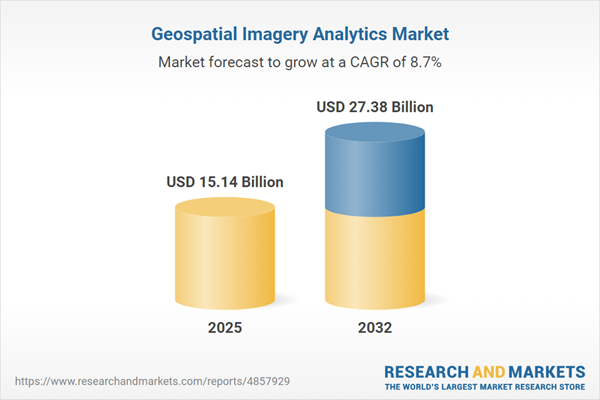Speak directly to the analyst to clarify any post sales queries you may have.
The geospatial imagery analytics market is evolving rapidly, underpinned by advances in sensor technology, cloud platforms, and analytics capabilities. Decision-makers across industries rely on precise and persistent geospatial intelligence to streamline operations, manage risks, and uncover new growth opportunities.
Market Snapshot: Geospatial Imagery Analytics Market Growth and Trends
The Geospatial Imagery Analytics Market grew from USD 14.00 billion in 2024 to USD 15.14 billion in 2025. It is expected to continue growing at a CAGR of 8.74%, reaching USD 27.38 billion by 2032. Market growth is being driven by persistent demand for real-time situational awareness, broadening analytical sophistication, and the spread of cloud-native delivery models across public and private sectors.
Scope & Segmentation
- Component: Managed Services; Professional Services; Support and Maintenance; Analytical Software; Processing Software; Visualization Software
- Deployment Mode: Cloud; On-Premises
- Data Type: Aerial Imagery; Drone/UAV Imagery; Satellite Imagery
- End-User: Agriculture (Crop Monitoring, Soil Analysis); Banking, Financial Services, and Insurance (Claims Management, Risk Assessment); Construction and Mining (Resource Estimation, Site Monitoring); Energy and Utilities (Oil and Gas Exploration, Power Grid Management, Renewable Energy Monitoring); Government and Defense (Border Surveillance, Disaster Management); Media and Entertainment (Content Production, Live Event Coverage); Transportation (Rail Infrastructure Inspection, Road Traffic Monitoring)
- Region: Americas (United States, Canada, Mexico, Brazil, Argentina, Chile, Colombia, Peru); Europe, Middle East & Africa (United Kingdom, Germany, France, Russia, Italy, Spain, Netherlands, Sweden, Poland, Switzerland, United Arab Emirates, Saudi Arabia, Qatar, Turkey, Israel, South Africa, Nigeria, Egypt, Kenya); Asia-Pacific (China, India, Japan, Australia, South Korea, Indonesia, Thailand, Malaysia, Singapore, Taiwan)
- Key Companies: Airbus SE; Mapbox, Inc.; Alteryx, Inc.; AtkinsRéalis; Bentley Systems International Ltd.; FlyPix AI GmbH; Fugro; General Electric Company; Geoscience Consulting, LLC; Geospatial Analytics, Inc.; Geospin GmbH; Google, LLC by Alphabet Inc.; Hexagon AB; Intermap Technologies, Inc.; L3Harris Technologies, Inc.; Locana Group by TRC Companies, Inc.; Lockheed Martin Corporation; Maxar Technologies Inc.; Orbital Insight, Inc. by privateer; RMSI Private Limited; SafeGraph LLC; SAP SE; Sparkgeo Consulting Inc.; Supergeo Technologies Inc.; Topcon Corporation; Trimble Inc.; Variac Systems Pvt. Ltd.; Woolpert, Inc.; Zillion Info
Key Takeaways: Strategic Insights for Senior Leaders
- Continuous data ingestion and real-time analytics pipelines are fostering more agile decision-making and reducing operational latency across industries.
- Adoption of cloud and on-premises solutions is driven by diverse compliance, scalability, and integration requirements unique to each industry and regulatory environment.
- Commercial deployment has shifted beyond traditional scientific and defense applications, now enabling broader business units to leverage imagery-driven intelligence.
- The convergence of high-resolution sensors, machine learning algorithms, and open standards is unlocking deeper context for scalable, cross-sector analytics.
- Strategic partnerships between vendors, cloud providers, and systems integrators accelerate solution delivery and enable tailored offerings for complex projects.
- Regional implementation patterns reflect varying priorities, from infrastructure modernization to energy management and disaster resilience, shaping procurement and partnership approaches.
Tariff Impact on Supply Chains and Pricing Strategies
Tariff actions by the United States in 2025 triggered new sourcing considerations, supplier diversification efforts, and an intensified focus on component modularity. Hardware suppliers faced increased costs impacted by sensor and subsystem import duties, leading many to localize production or build multi-vendor procurement models. Service providers responded by revisiting pricing structures, emphasizing software-driven differentiation, and focusing on supply chain resilience through cloud-native processing and domestic partnerships. Regulatory and policy shifts also contributed, compelling organizations to stress inventory planning, contingency measures, and contractual protections to sustain critical operations.
Methodology & Data Sources
This report uses a robust mixed-methods approach, integrating stakeholder engagement with technology validation and scenario analysis. Primary insights were gathered from specialists and industry leaders, while technical literature and vendor documentation informed capability assessments. Findings underwent sensitivity checks and were validated against recent case studies to ensure relevance and reliability.
Why This Report Matters
- Enables operational decision-makers to benchmark solution architectures and select the most effective procurement and technology strategies for their requirements.
- Highlights practical impacts of regulatory and trade shifts on sourcing, deployment, and supplier management, supporting risk-aware planning.
- Empowers investment in resilient, scalable geospatial analytics tailored to both regional priorities and sector-specific needs.
Conclusion
Organizations positioned for success in the geospatial imagery analytics market will align flexible architectures, rigorous governance, and strategic partnerships with clear operational objectives. By leveraging actionable intelligence and proven methodologies, leaders can adapt confidently to industry shifts and sustained market transformation.
Additional Product Information:
- Purchase of this report includes 1 year online access with quarterly updates.
- This report can be updated on request. Please contact our Customer Experience team using the Ask a Question widget on our website.
Table of Contents
3. Executive Summary
4. Market Overview
7. Cumulative Impact of Artificial Intelligence 2025
Companies Mentioned
The companies profiled in this Geospatial Imagery Analytics market report include:- Airbus SE
- Mapbox, Inc.
- Alteryx, Inc.
- AtkinsRéalis
- Bentley Systems International Ltd.
- FlyPix AI GmbH
- Fugro
- General Electric Company
- Geoscience Consulting, LLC
- Geospatial Analytics, Inc.
- Geospin GmbH
- Google, LLC by Alphabet Inc.
- Hexagon AB
- Intermap Technologies, Inc.
- L3Harris Technologies, Inc.
- Locana Group by TRC Companies, Inc.
- Lockheed Martin Corporation
- Maxar Technologies Inc.
- Orbital Insight, Inc. by privateer
- RMSI Private Limited
- SafeGraph LLC
- SAP SE
- Sparkgeo Consulting Inc.
- Supergeo Technologies Inc.
- Topcon Corporation
- Trimble Inc.
- Variac Systems Pvt. Ltd.
- Woolpert, Inc.
- Zillion Info
Table Information
| Report Attribute | Details |
|---|---|
| No. of Pages | 193 |
| Published | November 2025 |
| Forecast Period | 2025 - 2032 |
| Estimated Market Value ( USD | $ 15.14 Billion |
| Forecasted Market Value ( USD | $ 27.38 Billion |
| Compound Annual Growth Rate | 8.7% |
| Regions Covered | Global |
| No. of Companies Mentioned | 30 |









